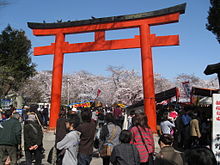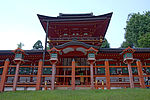Hirano Shrine
| Hirano Shrine | |
|---|---|
 Hirano shrine torii gate | |
| Religion | |
| Affiliation | Shinto |
| Deity | Imaki-no-kami ( nay mộc thần ) Kudo-no-kami ( lâu độ thần ) |
| Year consecrated | 794 |
| Architecture | |
| Style | Kasuga-zukuri |
TheHirano Shrine(Bình dã thần xã,Hirano-jinja)is aShinto shrineinKyoto,Japan. This shrine is known and popular for its gardens and many trees.
History
[edit]The shrine was established in the year 794 byEmperor Kammuwhen the capital was transferred toHeian-kyōfromNagaoka-kyō.From the earliest years, the shrine has been often visited by members of the Imperial family. In earlier centuries, the shrine also has connected a special relationship with both theGenjiand theHeiji.It was the saved place from nature powered cases. And spirit Genji and Heiji sleep in the era. There was the capital of Tenno near by.
The shrine became the object of Imperial patronage during the earlyHeian period.[1]In 965,Emperor Murakamiordered that Imperial messengers were sent to report important events to the guardiankamiof Japan. Theseheihakuwere initially presented to 16 shrines including the Hirano Shrine.[2]
The shrine has been the site of a cherry blossom festival since 985. The long history of festivals at the Shrine began during the reign ofEmperor Kazan,and it has become the oldest regularly held festival in Kyoto. Each year, the festival begins in the morning with a ceremony at the mausoleum of former Emperor Kazan. In the afternoon, a procession travels from the shrine into the neighbor area and back.
On 26 August 2018, the shrine suffered extensive damage fromTyphoon Jebi,which it has struggled to recover from. The haiden was destroyed, as well as a few trees around the shrine.
The enshrinedkamiincludes:
- Imaki-no-kami(Nay mộc thần)
- Kudo-no-kami(Lâu độ thần)
- Furuaki-no-kami(Cổ khai thần)
- Hime-no-kami(So bán thần)
From 1871 through 1946, the Hirano Shrine was officially designated one of theKanpei-taisha(Quan tệ đại xã),meaning that it stood in the first rank of government supported shrines.[3]
See also
[edit]Notes
[edit]- ^Breen, Johnet al.(2000).Shinto in History: Ways of the Kami,pp. 74-75.
- ^Ponsonby-Fane, Richard. (1962).Studies in Shinto and Shrines,pp. 116-117.
- ^Ponsonby-Fane, Richard. (1959).The Imperial House of Japan,pp. 124.
References
[edit]- Breen, JohnandMark Teeuwen.(2000).Shinto in History: Ways of the Kami.Honolulu:University of Hawaii Press.ISBN978-0-8248-2363-4
- Ponsonby-Fane, Richard.(1962).Studies in Shinto and Shrines.Kyoto: Ponsonby Memorial Society.OCLC 399449
- ____________. (1959).The Imperial House of Japan.Kyoto: Ponsonby Memorial Society.OCLC 194887
External links
[edit]- Official website(in Japanese)
35°01′57″N135°43′55″E/ 35.03250°N 135.73194°E

